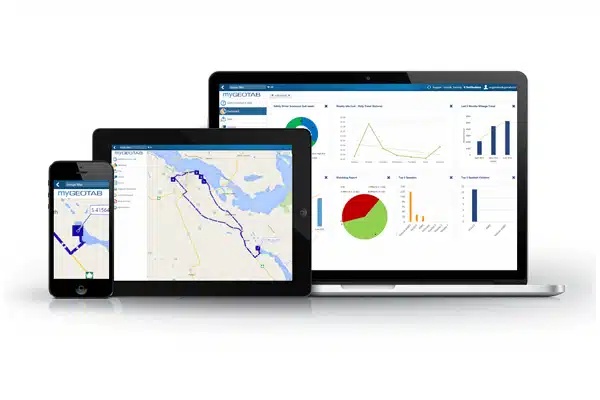In today’s fast-paced business landscape, the success of organizations relying on a fleet of vehicles hinges on the effectiveness of their fleet management strategy. Whether it’s a logistics company, a transportation service, or a construction firm, the ability to effectively manage and optimize a fleet is essential for maximizing operational efficiency, reducing costs, and ensuring customer satisfaction.
To achieve these goals, organizations must develop and implement a robust fleet management strategy that encompasses five key components.
The first component is asset management, which involves effectively tracking and maintaining vehicles to ensure optimal performance and longevity. We will discuss strategies for tracking and monitoring vehicle usage, implementing preventive maintenance programs, and optimizing vehicle lifecycles.
The second component is driver management, which focuses on training and supervising drivers to enhance safety, productivity, and customer service. We will delve into driver training programs, performance monitoring, and fostering a culture of accountability.
Cost management is the third key component, where we will explore strategies to reduce fuel costs, streamline maintenance expenses, and optimize overall fleet expenditures. We will discuss fuel-saving practices, proactive maintenance planning, and leveraging technology for cost control.
The fourth component is safety and compliance, which involves ensuring adherence to regulations and implementing measures to minimize accidents and liability. We will highlight strategies for driver safety training, regular inspections, and compliance with industry standards.
Finally, we will address the fifth component, which is technology and data. We will explore how leveraging advanced telematics systems, GPS tracking, and data analytics can provide valuable insights into fleet operations, improve decision-making, and enhance overall efficiency.
In this blog post, we will explore each of these components, providing valuable insights and practical tips for creating an effective fleet management strategy that can propel your business towards greater profitability and sustainable growth.
Join us as we dive into the world of fleet management excellence and discover how these key components can revolutionize your organization’s fleet operations.
Component #1: Asset Management
Vehicles are one of the most significant investments for organizations with fleets, and their reliable performance is crucial for meeting operational goals and customer expectations.
Poorly managed assets can lead to increased costs, reduced productivity, and even compromised safety. Hence, businesses must prioritize asset management as a key component of their fleet management strategy.
One of the key aspects of asset management is vehicle maintenance. Regular maintenance is vital for keeping vehicles in optimal condition, preventing breakdowns, and ensuring the safety of drivers and cargo.
A proactive approach to maintenance involves adhering to recommended service schedules, conducting routine inspections, and promptly addressing any identified issues. By implementing preventive maintenance programs, organizations can minimize unscheduled repairs and mitigate the risk of unexpected vehicle failures that can disrupt operations.
Implementing asset tracking systems is another essential aspect of effective asset management. Asset tracking allows businesses to monitor the location, usage, and performance of their vehicles in real-time. This technology provides valuable insights into factors such as route efficiency, fuel consumption, and idle time.
By leveraging asset tracking systems, fleet managers can identify areas for improvement, optimize routes, reduce unnecessary mileage, and enhance overall operational efficiency.
There are various methods and technologies available for asset tracking, ranging from simple GPS devices to advanced telematics systems. GPS devices provide location information, allowing fleet managers to monitor the movement of vehicles and track their routes.
Telematics systems, on the other hand, offer a more comprehensive approach by collecting and analyzing data on vehicle performance, driver behavior, and fuel consumption. These systems enable fleet managers to gain deeper insights into the overall health of their fleet and make data-driven decisions to improve asset management.
Beyond maintenance and tracking, effective asset management also involves optimizing vehicle lifecycles. By carefully managing the lifecycle of each vehicle in the fleet, organizations can maximize their value and minimize costs.
Fleet managers must consider factors such as depreciation, resale value, and technological obsolescence when determining the ideal time to replace vehicles. By replacing vehicles at the right time, businesses can avoid excessive maintenance expenses on aging vehicles, take advantage of technological advancements, and maintain a modern and efficient fleet.
To effectively manage fleet assets, businesses should consider implementing a robust fleet management software solution. These software platforms provide a centralized hub for asset tracking, maintenance scheduling, and performance monitoring. They offer features such as automated maintenance reminders, real-time diagnostics, and customizable reporting, enabling fleet managers to streamline asset management processes and make informed decisions.
Furthermore, businesses can benefit from establishing strong partnerships with service providers and suppliers. Collaborating with reliable vendors who offer quality vehicle maintenance services, genuine spare parts, and competitive pricing can contribute to efficient asset management. Additionally, fleet managers should maintain open lines of communication with drivers and empower them to report any maintenance issues promptly.
This proactive approach ensures that vehicles receive timely attention, reducing the risk of minor issues escalating into major problems.
Component #2: Driver Management
Driver management plays a critical role in fleet management and its significance cannot be emphasized enough. Drivers are the backbone of any fleet operation, as they are responsible for transporting goods, interacting with customers, and representing the organization on the road.
Well-managed drivers contribute to increased productivity, reduced costs, and enhanced customer satisfaction. Conversely, poor driver management can result in accidents, increased fuel consumption, negative customer experiences, and potential legal liabilities. Hence, businesses must prioritize driver management as a key component of their fleet management strategy.
One of the primary aspects of effective driver management is comprehensive driver training. Well-trained drivers are equipped with the skills and knowledge necessary to operate vehicles safely, efficiently, and in compliance with regulations.
Driver training programs should cover various topics such as defensive driving techniques, vehicle handling, customer service, and adherence to company policies. By investing in driver training, businesses can mitigate risks, prevent accidents, and create a culture of safety within their fleet.
Performance monitoring is another critical element of driver management. Fleet managers need to have mechanisms in place to monitor driver behavior and performance to identify areas for improvement and ensure compliance with company policies.
This can be accomplished through various methods, such as telematics systems and driver scorecards. Telematics systems provide real-time data on factors like speed, braking, acceleration, and idling, allowing fleet managers to identify risky behaviors and take appropriate actions.
Driver scorecards provide a holistic view of driver performance based on predetermined metrics, enabling fleet managers to recognize high-performing drivers and address areas that require improvement.
To effectively manage drivers, businesses should also foster a culture of accountability and continuous improvement. This can be achieved by setting clear expectations, communicating company policies, and regularly providing feedback to drivers.
Regular performance reviews and one-on-one meetings can help identify individual training needs and address any concerns or challenges faced by drivers. Recognizing and rewarding drivers for their achievements and safe driving practices can further motivate them and reinforce positive behaviors.
In addition to training and performance monitoring, businesses can leverage technology to enhance driver management. For instance, driver-facing technology, such as in-cab coaching systems, can provide real-time feedback to drivers on their driving behaviors.
These systems can alert drivers to harsh acceleration or braking, speeding, or other unsafe driving practices, promoting self-correction and reducing the risk of accidents.
Furthermore, fostering open lines of communication between fleet managers and drivers is vital for effective driver management. Drivers should feel comfortable reporting any issues, concerns, or incidents they encounter on the road.
Regular communication channels, such as driver meetings, newsletters, or digital platforms, can facilitate the exchange of information, best practices, and updates regarding company policies or industry regulations.
Ultimately, businesses must prioritize driver safety and well-being. Providing ongoing support and resources for drivers, such as access to driver assistance programs or wellness initiatives, can contribute to their job satisfaction, reduce stress, and improve overall performance.
Moreover, recognizing the importance of work-life balance and implementing policies that promote reasonable working hours and rest periods can enhance driver alertness, reduce fatigue-related risks, and increase overall safety.
Well-trained and responsible drivers directly impact the safety, efficiency, and reputation of fleet operations. By investing in driver training, monitoring driver performance, fostering a culture of accountability, leveraging technology, and prioritizing driver safety and well-being, businesses can optimize driver management and achieve significant benefits.
A comprehensive driver management strategy contributes to reduced accidents, improved fuel efficiency, enhanced customer service, and increased overall operational efficiency. By effectively managing drivers, businesses can create a competitive advantage in the fleet management industry.
To ensure the effectiveness of driver management, businesses should establish clear policies and procedures that outline expectations for driver behavior and performance. These policies should cover areas such as adherence to traffic laws, vehicle maintenance responsibilities, customer service protocols, and compliance with company rules and regulations.
By setting clear expectations from the start and communicating them effectively, businesses can establish a foundation for driver management success.
Regular driver training and education programs are vital for keeping drivers up to date with best practices, industry regulations, and new technologies. These programs can be conducted in various formats, including classroom sessions, online courses, and hands-on training.
Topics such as defensive driving techniques, accident prevention, vehicle inspection procedures, and customer service skills should be covered to ensure drivers have the necessary knowledge and skills to excel in their roles.
Performance monitoring and feedback are crucial for identifying areas of improvement and recognizing high-performing drivers. Fleet managers can use telematics systems and driver scorecards to track driver behavior, identify trends, and provide constructive feedback to drivers.
Regular performance reviews should be conducted to discuss performance metrics, address concerns, and set goals for improvement. By monitoring driver performance and providing feedback, businesses can promote continuous improvement and ensure drivers are aligned with the organization’s goals.
In addition to training and monitoring, businesses should prioritize driver safety and well-being. This includes enforcing strict policies against distracted driving, speeding, and other risky behaviors. It also involves providing drivers with the necessary resources and support to maintain their physical and mental well-being.
Offering incentives for safe driving practices, such as rewards or recognition programs, can further motivate drivers to prioritize safety.
Technology plays a significant role in driver management as well. Advanced telematics systems can provide real-time data on driver behavior, vehicle performance, and route optimization. This data can be used to identify areas for improvement, optimize routes, and enhance fuel efficiency.
In-cab coaching systems can deliver immediate feedback to drivers, promoting safer driving habits in real-time. Additionally, driver management software can streamline administrative tasks, such as scheduling and compliance documentation, freeing up time for fleet managers to focus on driver training and performance management.
Effective driver management also requires open lines of communication between fleet managers and drivers. Establishing regular channels for communication, such as driver meetings, newsletters, or digital platforms, allows drivers to voice their concerns, share feedback, and stay informed about important updates.
This communication fosters a sense of collaboration and engagement, ensuring that drivers feel valued and supported by the organization.
Component #3: Cost Management in Fleet Management Strategy
Cost management directly impacts the financial health and profitability of an organization. The ability to manage and control fleet costs is crucial for businesses that rely on a fleet of vehicles, as it allows them to optimize their operations, improve their bottom line, and maintain a competitive edge in the industry.
The importance of cost management in fleet management cannot be overstated. Fleet operations incur various expenses, including fuel costs, vehicle maintenance, insurance, licensing, and depreciation.
Inefficient cost management can result in unnecessary expenditures, reduced profitability, and compromised financial stability. Therefore, businesses must prioritize cost management as a key component of their fleet management strategy.
One of the primary areas of cost management in fleet management is fuel efficiency. Fuel costs can represent a significant portion of a fleet’s operating expenses, especially in industries with high mileage requirements. Businesses can implement several strategies to improve fuel efficiency and reduce fuel consumption.
These strategies include driver training programs focused on fuel-efficient driving techniques, route optimization to minimize mileage, and adopting advanced technologies such as GPS tracking and telematics systems that provide real-time data on fuel usage and driver behavior. By prioritizing fuel efficiency, businesses can significantly reduce their fuel costs and enhance their overall cost management.
Effective maintenance management is another crucial aspect of cost management in fleet operations. Well-maintained vehicles are more reliable, experience fewer breakdowns, and have lower repair costs. Implementing a proactive approach to maintenance involves adhering to regular service schedules, conducting preventative maintenance inspections, and addressing any identified issues promptly.
Additionally, businesses can leverage fleet management software or maintenance management systems to automate maintenance reminders, track maintenance history, and streamline repair processes. By prioritizing maintenance, businesses can minimize unscheduled repairs, increase the lifespan of their vehicles, and effectively manage maintenance costs.
Proper vehicle selection and lifecycle management also contribute to effective cost management. Choosing the right vehicles for the specific operational requirements of the fleet, including payload capacity, fuel efficiency, and maintenance costs, can significantly impact long-term cost management. Additionally, managing the lifecycle of vehicles involves determining the optimal time for vehicle replacement.
Replacing vehicles at the right time minimizes maintenance costs associated with older vehicles and takes advantage of new technologies that offer improved fuel efficiency and performance. By strategically managing vehicle selection and lifecycle, businesses can effectively control costs and optimize their fleet operations.
Insurance costs are another significant aspect of fleet cost management. Businesses should assess their insurance policies to ensure they have appropriate coverage while avoiding overpayment. Regularly reviewing insurance policies, comparing quotes from different providers, and considering risk management strategies can help identify cost-saving opportunities. Additionally, implementing measures to promote driver safety and reduce accidents can lead to lower insurance premiums over time.
To further manage fleet costs, businesses can explore opportunities for bulk purchasing or negotiating favorable contracts with suppliers. Consolidating orders or contracts for fuel, maintenance services, and vehicle purchases can lead to cost savings through economies of scale or preferential pricing. Building strong relationships with suppliers and maintaining open lines of communication can also provide businesses with insights into potential cost-saving opportunities or industry trends.
Leveraging technology is crucial for effective cost management in fleet operations. Advanced fleet management software and telematics systems provide real-time data on various aspects of fleet operations, including fuel consumption, driver behavior, vehicle performance, and maintenance schedules. By analyzing this data, businesses can identify inefficiencies, pinpoint areas for improvement, and make data-driven decisions to optimize their fleet operations and reduce costs.
Additionally, telematics systems can provide insights into route optimization, helping businesses minimize unnecessary mileage and fuel consumption.
Regular analysis and reporting of fleet costs are essential to effective cost management. By monitoring and analyzing expenses associated with fuel, maintenance, insurance, and other operational costs, businesses can identify trends, patterns, and cost-saving opportunities.
Utilizing fleet management software or financial management tools can streamline this process by providing accurate and up-to-date cost data. By identifying areas of inefficiency or high costs, businesses can implement targeted strategies to reduce expenses and improve cost management.
Another aspect of cost management is optimizing inventory and parts management. Efficient inventory management ensures that the necessary spare parts and supplies are available when needed, reducing downtime and minimizing emergency repair costs.
Implementing inventory management systems, establishing reliable supplier relationships, and tracking parts usage can help businesses avoid stockouts, overstocking, or obsolescence, leading to cost savings and improved operational efficiency.
Additionally, businesses should consider implementing cost control measures, such as fuel card programs, to monitor and regulate fuel expenses. Fuel cards can provide detailed transaction data, allowing businesses to track fuel consumption, detect anomalies or unauthorized use, and implement fuel consumption policies. This enables better control over fuel costs and ensures that fuel is used solely for business purposes.
It’s also crucial to involve drivers in the cost management process. Educating drivers about the impact of their driving behaviors on fuel efficiency and maintenance costs can encourage responsible driving practices.
Incentive programs that reward drivers for fuel-efficient driving, reducing idle time, or reporting maintenance issues promptly can further promote cost-conscious behaviors. By engaging drivers as active participants in cost management, businesses can foster a culture of responsibility and collaboration.
Finally, businesses should regularly review and benchmark their fleet’s performance and costs against industry standards and best practices. Industry associations, conferences, and networking events can provide valuable insights into innovative cost management strategies and industry benchmarks. By staying informed about the latest trends and developments in fleet management strategy, businesses can continuously improve their cost management practices and maintain a competitive edge.
Component #4: Safety and Compliance in Fleet Management Strategy
Safety and compliance directly impact the well-being of drivers, the public, and the overall success of the organization. Maintaining a strong focus on safety and compliance is not only a legal and ethical obligation but also a strategic imperative for businesses that rely on a fleet of vehicles. By prioritizing safety and compliance, businesses can reduce accidents, minimize liabilities, enhance their reputation, and ensure the longevity of their operations.
The consequences of accidents can be severe, including injuries, fatalities, property damage, legal liabilities, and negative brand reputation. Moreover, non-compliance with regulations can result in fines, penalties, and potential disruption of operations. Therefore, businesses must prioritize safety and compliance as a key component of their fleet management strategy.
To ensure fleet operations operate safely and comply with regulations, businesses should establish comprehensive driver safety programs. These programs should encompass driver training on safe driving practices, defensive driving techniques, and adherence to traffic laws.
Training should also address specific risks and challenges relevant to the industry or operational environment. By investing in driver safety training, businesses can equip their drivers with the knowledge and skills necessary to navigate the roads safely.
In addition to driver training, businesses should implement measures to monitor and manage driver behavior. This can be achieved through the use of telematics systems, which provide real-time data on driver performance, including speed, acceleration, braking, and adherence to traffic regulations.
By tracking driver behavior and providing feedback on unsafe practices, businesses can identify areas for improvement, implement corrective actions, and foster a culture of safe driving.
Compliance monitoring is another crucial aspect of safety and compliance in fleet management. Businesses must ensure that their operations adhere to industry regulations, local laws, and company policies.
This involves conducting regular audits and inspections to assess compliance with regulations related to vehicle maintenance, driver hours of service, licensing, and safety standards. Fleet managers should also stay informed about any regulatory changes and update their policies and procedures accordingly.
Implementing technology solutions can greatly assist in safety and compliance efforts. For instance, advanced telematics systems can provide real-time data on vehicle performance, maintenance needs, and driver behavior. These systems can also alert fleet managers about potential safety violations or deviations from compliance requirements. In-cab cameras can be used to monitor driver behavior and provide objective evidence in case of accidents or disputes. Utilizing software applications or mobile apps can help streamline compliance documentation, recordkeeping, and reporting.
Businesses should also establish strong partnerships with service providers and suppliers who prioritize safety and compliance. Collaborating with reliable vendors ensures that vehicles receive proper maintenance, repairs, and inspections from qualified professionals.
Working with reputable suppliers for fuel, parts, and other services helps ensure the quality and safety of the products and services utilized in fleet operations. Regular communication with suppliers can also provide insights into best practices and regulatory updates relevant to safety and compliance.
Maintaining open lines of communication between fleet managers and drivers is essential for promoting safety and compliance. Drivers should have a clear understanding of their responsibilities and feel comfortable reporting safety concerns, incidents, or violations. Fleet managers should actively listen to driver feedback and address any safety-related issues promptly.
Regular safety meetings, safety bulletins, or safety recognition programs can also help reinforce the importance of safety and foster a safety-conscious culture within the organization.
Businesses must also prioritize ongoing safety and compliance training and education for all personnel involved in fleet operations, including drivers, supervisors, and management. This includes staying updated on changes in regulations, industry standards, and best practices.
Attending conferences, industry events, and workshops focused on safety and compliance can provide valuable insights and networking opportunities to enhance safety practices.
Regular evaluation and analysis of safety data and metrics are crucial for identifying areas of improvement and measuring the effectiveness of safety and compliance efforts.
Key performance indicators (KPIs) such as accident rates, near-miss incidents, driver compliance scores, and regulatory compliance audits can provide valuable insights into the overall safety and compliance performance of the fleet.
By analyzing these metrics, businesses can identify trends, root causes, and areas for improvement. This data-driven approach allows for targeted interventions and the implementation of corrective actions to enhance safety and compliance.
Businesses should also promote a culture of safety and compliance from the top-down. Management should lead by example, demonstrating a strong commitment to safety and compliance through their actions and decisions.
Clear communication of safety policies, procedures, and expectations is essential. Regular safety communications, reminders, and recognition programs can reinforce the importance of safety and foster a safety-conscious culture among drivers and employees.
Furthermore, businesses should encourage and incentivize safe driving practices. Driver recognition programs that reward safe driving behavior can motivate drivers to prioritize safety. Incentives can include monetary rewards, bonuses, or recognition in company newsletters or meetings.
Positive reinforcement and recognition not only promote safer driving but also create a positive work environment that encourages employees to actively contribute to the overall safety and compliance goals of the organization.
Regular review and analysis of accident data and incident reports are also vital for continuous improvement in safety and compliance. By investigating accidents and incidents, businesses can identify contributing factors, implement corrective actions, and prevent similar incidents in the future.
These findings should be communicated to drivers and incorporated into ongoing training programs to raise awareness and promote a learning culture within the organization.
Collaboration with industry associations and participation in safety programs can further enhance safety and compliance efforts. Many industries have specific safety initiatives, guidelines, or certifications that businesses can engage with.
Participating in these programs not only demonstrates a commitment to safety but also provides access to resources, training materials, and best practices that can benefit fleet operations.
Lastly, businesses should regularly review their safety and compliance policies and procedures to ensure they are up-to-date and aligned with industry standards and regulations.
Staying informed about changes in legislation and industry best practices is crucial to maintaining compliance. Fleet managers should conduct regular audits and assessments to identify gaps and implement necessary updates to policies and procedures.
Component #5: Technology and Data in Fleet Management Strategy
Technology and data play a pivotal role in driving efficiency, enhancing decision-making, and ensuring the long-term success of organizations. The integration of advanced technologies and effective data management has revolutionized the way fleets operate, enabling businesses to optimize their operations, improve customer service, and achieve a competitive advantage.
Therefore, businesses must embrace technology and leverage data as a key component of their fleet management strategy.
Technology enables businesses to gather real-time information, automate processes, and gain valuable insights into various aspects of their fleet operations. Data, on the other hand, empowers businesses with actionable intelligence to make informed decisions, identify areas for improvement, and drive operational efficiency.
By harnessing the power of technology and data, businesses can unlock significant opportunities for growth and success.
One of the key technologies in fleet management is GPS tracking. GPS tracking systems provide real-time visibility into the location and movement of vehicles. By tracking vehicles’ positions, fleet managers can monitor routes, identify potential delays or inefficiencies, and make informed decisions for route optimization.
GPS tracking also enables businesses to enhance customer service by providing accurate and reliable estimated arrival times. Additionally, in the event of theft or vehicle misuse, GPS tracking systems can assist in vehicle recovery and promote security.
Data analytics is another critical aspect of technology in fleet management. The abundance of data collected from various sources, including vehicles, drivers, and external factors, can be analyzed to extract valuable insights. Data analytics allows businesses to identify patterns, trends, and anomalies, facilitating better decision-making and operational improvements.
For example, by analyzing fuel consumption data, businesses can identify inefficient vehicles or drivers and implement strategies to improve fuel efficiency. Similarly, analyzing driver behavior data can help identify areas for driver training and improvement, leading to enhanced safety and reduced risks.
Telematics systems are powerful tools that leverage technology and data to provide comprehensive insights into fleet operations. These systems collect data from various sources, including vehicle sensors, GPS tracking, and driver behavior, and provide real-time visibility and analysis of key metrics.
Telematics systems enable businesses to monitor vehicle performance, fuel consumption, maintenance needs, driver behavior, and compliance with safety regulations. This information can be used to optimize routes, improve fuel efficiency, enhance maintenance schedules, and ensure compliance with regulations, leading to cost savings and operational efficiencies.
The integration of technology and data also facilitates proactive maintenance management. Predictive maintenance systems utilize data from vehicle sensors and historical maintenance records to predict potential issues or failures.
By analyzing this data, businesses can schedule maintenance and repairs before breakdowns occur, minimizing unscheduled downtime and reducing maintenance costs. Proactive maintenance not only increases the lifespan of vehicles but also enhances safety, as well-maintained vehicles are less likely to experience unexpected failures on the road.
In recent years, the emergence of the Internet of Things (IoT) has further transformed fleet management strategy. IoT devices and sensors can be installed on vehicles to collect and transmit real-time data on factors such as tire pressure, engine performance, fuel levels, and environmental conditions.
This data can be analyzed to optimize vehicle performance, identify maintenance needs, and ensure compliance with safety regulations. The IoT also enables businesses to monitor driver behavior, such as seatbelt usage or driver fatigue, and take appropriate actions to improve safety.
Cloud computing and software solutions have revolutionized data management in fleet operations. Cloud-based fleet management software provides a centralized platform for data storage, analysis, and reporting. These software solutions enable businesses to access real-time data, generate customized reports, and streamline administrative tasks.
Fleet managers can monitor key metrics, such as fuel consumption, vehicle utilization, maintenance history, and driver performance, all from a single interface. This centralized approach enhances data visibility, enabling businesses to make data-driven decisions and quickly respond to operational challenges or opportunities.
Another significant technology in fleet management strategy is route optimization software. This software leverages algorithms and real-time data to identify the most efficient routes for vehicles. By optimizing routes, businesses can minimize mileage, reduce fuel consumption, and enhance overall operational efficiency.
Route optimization software takes into account factors such as traffic conditions, customer locations, and delivery time windows, ensuring that vehicles reach their destinations in the most time and cost-effective manner.
Intelligent dashboards and reporting tools are valuable components of technology and data utilization in fleet management. These tools consolidate and visualize key performance indicators (KPIs) and metrics, allowing fleet managers to easily track and monitor the performance of their fleet.
Through intuitive graphical representations, such as charts and graphs, fleet managers can quickly identify areas of concern, trends, and opportunities for improvement. This enables them to take proactive measures and make informed decisions to optimize fleet operations.
Furthermore, businesses can leverage technology to promote driver safety and improve driver behavior. In-cab coaching systems provide real-time feedback to drivers on their driving habits, such as harsh acceleration, braking, or speeding. These systems help drivers self-correct unsafe behaviors, ultimately reducing the risk of accidents.
Additionally, driver-facing cameras can be installed to monitor driver behavior and provide objective evidence in case of accidents or disputes. The availability of such technology not only improves safety but also serves as a tool for driver training and development.
To effectively leverage technology and data, businesses should prioritize ongoing training and education for their staff. Fleet managers and employees must have the necessary skills and knowledge to utilize technology solutions and interpret data effectively.
Training programs should cover topics such as data analysis, software usage, and understanding key performance indicators. By investing in training, businesses can ensure that their workforce is equipped to maximize the benefits of technology and data in fleet management.
It’s important to note that while technology and data offer numerous advantages, businesses should also consider data security and privacy. Proper data governance and security measures should be implemented to protect sensitive information and comply with relevant data protection regulations. This includes ensuring secure data storage, using encryption methods, and establishing access controls to safeguard data from unauthorized access or breaches.
Conclusion
In this article, we have explored five key components of an effective fleet management strategy: asset management, driver management, cost management, safety and compliance, and technology and data. Each component plays a crucial role in optimizing fleet operations, reducing costs, enhancing safety, and ensuring regulatory compliance.
Asset management involves tracking and maintaining vehicles to maximize their performance and lifespan. Driver management focuses on training, monitoring, and incentivizing drivers to promote safe and efficient driving practices.
Cost management aims to reduce expenses through strategies like fuel efficiency measures, maintenance optimization, and smart procurement practices. Safety and compliance prioritize driver and public safety, as well as adherence to regulations and industry standards.
Finally, technology and data utilization enable businesses to leverage tools like GPS tracking, data analytics, telematics systems, and cloud-based software to gain real-time visibility, improve decision-making, and drive operational efficiencies.
Businesses should consider these five key components when developing their fleet management strategy. By incorporating these components into their approach, businesses can unlock the full potential of their fleet, reduce costs, enhance safety, and achieve a competitive advantage in the industry.
It is crucial for businesses to prioritize ongoing training, stay informed about industry trends and best practices, and seek expert guidance when needed to maximize the effectiveness of their fleet management strategy.
In the ever-evolving landscape of fleet management, organizations must embrace innovation, leverage technology, and utilize data to stay ahead. By prioritizing these key components and continuously refining their fleet management strategy, businesses can position themselves for long-term success, increased profitability, and sustainable growth in the dynamic world of fleet operations.
Are you ready to improve your fleet management strategy and achieve your business goals? Contact us today to learn how our expertise in fleet management can help you develop an effective strategy that maximizes efficiency, reduces costs, and ensures compliance. Our team of experts is here to guide you through the process and provide tailored solutions to meet your specific needs. Don’t wait any longer, schedule a consultation now and see how we can transform your fleet management operations.














